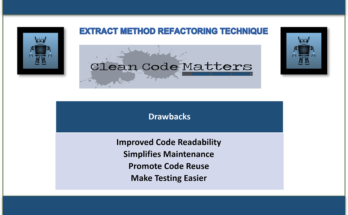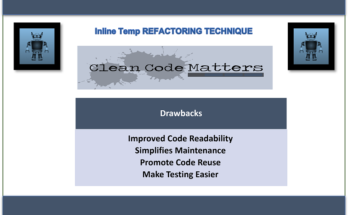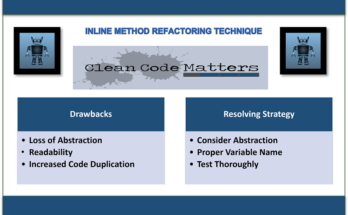To replace temporary variables with methods or functions that calculate the same value, use the “Replace Temp with Query” refactoring approach. Removing temporary variables and making the code more self-explanatory, enhances the code’s readability and maintainability.

Ways to Apply Replace Temp with Query Technique
To apply the “Replace Temp with Query” refactoring technique, follow these steps:
- Choose a temporary variable in your program that stores a value arrived at by combining other variables or expressions.
- Check to see if the temporary variable is required more than once or if a method call would be better appropriate.
- Make a new procedure or function to represent the computation of the temporary variable carried out. Any required input parameters should be provided, and the procedure should return the calculated value.
- All references to the temporary variable should be changed to calls to the new method or function.
- Verify the behavior hasn’t changed by testing the code.
Problem
You store the solution to an equation in a local variable so that you can utilize it later in your code.
Before Refactoring
def calculate_total_price(quantity, unit_price):
discount = 0.1
total = quantity * unit_price
total -= total * discount
return total
Solution
Move the entire expression to another method, then return the outcome. Instead of using a variable for the function, use a query. Integrate the new strategy into current methodologies as necessary.
After Refactoring
def calculate_total_price(quantity, unit_price):
discount = 0.1
total = quantity * unit_price
return apply_discount(total, discount)
def apply_discount(amount, discount):
return amount - amount * discount
In the refactored code, we introduced the apply_discount function, which calculates the discounted amount based on the original amount and the discount. The temporary variable total was replaced with a call to apply_discount. This makes the code more readable and eliminates the need for the temporary variable.
You can streamline your code, make it easier to maintain, and clarify the purpose of the computations being made by using the “Replace Temp with Query” refactoring technique.
Drawbacks of Replace Temp with Query Refactoring Technique
There are a few limitations to take into account, even if the “Replace Temp with Query” refactoring technique can be helpful in many situations:
- Performance impact: Using query methods or functions in place of temporary variables can result in more method calls, which could somewhat affect performance, particularly if the calculations are intricate or involve a lot of processing. Modern compilers frequently lessen this effect though, and the trade-off for better code readability and maintainability is typically worthwhile.
- Code readability: Although the aim of this refactoring approach is to improve code readability, there may be instances where substituting searches for temporary variables results in more difficult-to-understand code. The code may become less understandable and put more mental strain on developers if the queries are complicated or the method names are not self-explanatory.
- The proliferation of methods or functions: Adding additional methods or functions for every calculation may result in an excessive number of minor methods or functions, which may clog the codebase. It’s crucial to strike a balance and refrain from adding too many query methods that could not be very useful or complicate the navigation of the codebase.
Resolving Strategy
To address these drawbacks and ensure a successful application of the “Replace Temp with Query” refactoring technique, consider the following strategies:
- Optimise performance as appropriate. If you discover performance issues brought on by the addition of extra method calls, you can examine the crucial portions of your code and think about separately optimizing specific areas. This could entail storing results in a cache, using memoization methods, or investigating algorithmic advancements.
- When using queries in place of temporary variables, be sure to identify the methods or functions in a way that makes their function and the value they calculate clear. For upcoming developers, carefully picked names will improve code readability and lessen confusion.
- Consolidate similar queries: Instead of developing numerous little query methods, think about combining related queries into a single method or a limited number of methods. This can keep the readability and clarity of the code while reducing the number of methods.
- consider the bigger picture: Be mindful of your codebase’s broader context and the development team working on it. The possible negatives may be outweighed if the “Replace Temp with Query” refactoring considerably increases the overall maintainability and comprehension of the code. To choose the best strategy, evaluate the project’s unique requirements and restrictions.
You can also visit other blogs to better understand the most recent hot topics in technology.



One Comment on “Replace Temp with Query | Drawbacks and Resolving Strategy”